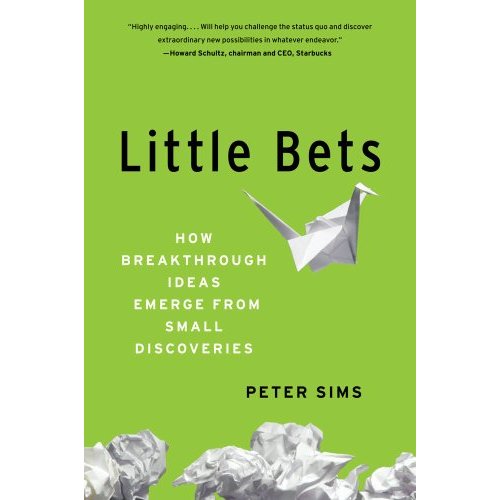
April 13, 2011
If at First You Don’t Succeed, Pat Yourself on the Back

For decades, the relationship between designer and client has been viewed as one of tense yet productive opposition. The client sets forth a brief and a budget; the designer pushes against these constraints with a torrent of ideas. When the dust clears, in the best scenarios, a beautiful synthesis is born.
Despite its complementary nature, this process supposes a necessary estrangement. Like two brain hemispheres, designers and clients represent alien forces that operate better together than independently. Clients need designers to clarify and promote their objectives. Designers need clients to inspire and tame their creative energies. Each grumbles incessantly about the other’s irritating ways. Yin and Yang. Id and superego. Can’t live with them; can’t live without them.
Then “design thinking” came along. Design thinking is an approach to problem solving that invites clients to adopt the designer’s process, the better to understand why they need design in the first place. Design thinkers are asked to fuse brain hemispheres and be luxuriantly expansive, issuing or sifting through ideas with abandon before narrowing the flood to a trickle. Constraints aren’t just the brief or budget but also the idea’s potential to survive in the real world — buffeted by user needs and market forces — as determined by multiple iterations. Some version of the idea is fabricated and released like an Outward Bound camper into the wilderness, then brought home and refined and released again. New ideas bud off and branch in unpredictable directions.
The process encourages risk-taking within a framework of prudence imposed from the outside. It is of course what designers do by nature with their successions of thumbnails, mockups and prototypes, which is why some designers puzzle over the avowed freshness of the phrase “design thinking,” not to mention its redundancy.
It is also why books like Little Bets: How Breakthrough Ideas Emerge from Small Discoveries aren’t really meant for designers, at least not those of the old school. Written by Peter Sims, a former venture capitalist with ties to Stanford’s d.school, Little Bets connects the current or erstwhile success of companies such as Pixar, Belkin, Starbucks and Hewlett-Packard with unrestrained, even haphazard, creative efforts that frequently go nowhere. Products and strategies are introduced and quickly abandoned, a company’s entire purpose may even change, as in Pixar’s case, but what seems like chaotic flailing — a series of “little bets” with uncertain odds — ultimately leads to a wildly successful invention or direction.
“At the core of this experimental approach,” Sims writes, “little bets are concrete actions taken to discover, test, and develop ideas that are achievable and affordable. They begin as creative possibilities that get iterated and refined over time, and they are particularly valuable when [one is] trying to navigate amid uncertainty, create something new, or attend to open-ended problems. When we can’t know what’s going to happen, little bets help us learn about the factors that can’t be understood beforehand.”
Of course, Sims might have added, we never know what’s going to happen. In his view, the risk aversion that leads businesses to follow formulas and try to repeat past successes is poisonous when each day may bring a new category-killing invention from a competitor or another unanticipated plunge in the stock market. Ideas can’t be developed in a theoretical vacuum; they must be worked out in some sort of palpable form, subjected to stresses, and revised accordingly. A brief is only the articulation of what a company and its market think they might possibly want, subject to change. And failure isn’t a visible pothole one anticipates and skirts on the road to success, but something to be embraced for the information it imparts, a revelation and an education.
Perhaps because he is writing for entrepreneurs who may be unfamiliar with design processes, Sims makes only sparing use of the phrase “design thinking” and doesn’t identify the free ideation and prototyping he advocates with designers’ daily habits. Instead he showcases one designer engaging in an iterative process — Frank Gehry realizing his Disney Concert Hall through scores of sketches and models, an operation that Sims narrates in parallel with Howard Schultz realizing his Starbucks after multiple iterations of a coffee house and Obama’s election team realizing its voter outreach strategy after numerous ideas involving internet and mobile phone technology.
Sims’s prescription for the kind of workplace environment that stimulates creative output will also be familiar to designers: it’s informal, nonhierarchical, interdisciplinary, playful, and demanding. Criticism is part of the daily discourse, but it’s friendly and positive so as not to crush souls. Bosses rub elbows with employees and the most menial hire is encouraged to weigh in. Maybe Sims should have also suggested black T-shirts and tortoise-shell eyeglasses?
The key to making small bets, the author believes, is being able to afford the stakes. The entrepreneur has to budget for failure in the way that the designer has to be able to sustain the cost of time and midnight oil that comes from conceiving bunches of potentially dead-end ideas. For the most part, Sims lays these well-worn concepts out in lucid, readable prose. A firmer editorial hand could have forestalled a few grammatical errors (such as the missing subject I introduced in one of the quotes above). It might have cured the following sentence of its repetition: “Schultz’s grand vision was to create a different kind of coffee experience that he called the ‘Starbucks experience’: where people could experience great coffee in a communal place.” (Somewhere in the rich loam of the English language must be a synonym for “experience.”) Sims also makes easy use of terms such as “tipping point,” “outliers,” and, well, “design thinking,” as if they have been embedded in our culture for centuries. (Curiously, he cites Malcolm Gladwell only once — to dismiss his ideas as derivative. And nowhere do Gladwell’s books appear in the bibliography or notes.)
Overall, however, Little Bets goes down easily. Designers who have the self-confidence not to fear that businesspeople are out to appropriate their methodologies, services and eyewear may find the message of risk-taking reassuring. This is also a good primer for designers who are joining the wagon train crossing the right brain/left brain divide in the other direction and seeking to become more entrepreneurial themselves.
Observed
View all
Observed
By Julie Lasky
Recent Posts
Why scaling back on equity is more than risky — it’s economically irresponsible Beauty queenpin: ‘Deli Boys’ makeup head Nesrin Ismail on cosmetics as masks and mirrors Compassionate Design, Career Advice and Leaving 18F with Designer Ethan Marcotte Mine the $3.1T gap: Workplace gender equity is a growth imperative in an era of uncertainty
 Julie Lasky is editor of Change Observer. She was previously editor-in-chief of
Julie Lasky is editor of Change Observer. She was previously editor-in-chief of 


